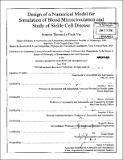| dc.contributor.advisor | Wesley L. Harris. | en_US |
| dc.contributor.author | Le Floch-Yin, François T. (François Thomas) | en_US |
| dc.contributor.other | Massachusetts Institute of Technology. Dept. of Aeronautics and Astronautics. | en_US |
| dc.date.accessioned | 2010-10-29T18:04:17Z | |
| dc.date.available | 2010-10-29T18:04:17Z | |
| dc.date.copyright | 2010 | en_US |
| dc.date.issued | 2010 | en_US |
| dc.identifier.uri | http://hdl.handle.net/1721.1/59658 | |
| dc.description | Thesis (Ph. D.)--Massachusetts Institute of Technology, Dept. of Aeronautics and Astronautics, 2010. | en_US |
| dc.description | Cataloged from PDF version of thesis. | en_US |
| dc.description | Includes bibliographical references (p. 214-226). | en_US |
| dc.description.abstract | Sickle cell disease is nowadays one of the most challenging blood diseases, where patients suffer from both chronic and acute episodes of painful medical conditions. In particular, unpredictable crises due to blood vessel occlusion remain one of the least understood stages of the disease, which focuses the attention of medical research. A novel methodology has been developed to address sickle cell disease, based on highly descriptive mathematical models for blood flow in the capillaries. The main focus of our original sickle cell model is the coupling between oxygen delivery and red blood cell dynamics, which is crucial to understanding sickle cell crises and is unique to this blood disease. Based on an original physical description of polymerizing sickle hemoglobin (HbS), an extensive study of blood dynamics was initiated through simulations of red cells deforming within the capillary vessels. Our investigations relied on the use of a large mathematical system of equations describing oxygen transfer, blood plasma dynamics and red cell membrane mechanics. Abnormal dynamics were characterized in terms of resistance to blood flow (apparent viscosity), and oxygen delivery performance. The results presented in this thesis describe successfully qualitative and quantitative aspects of blood dynamics preceding sickle cell crises, through a detailed comparison of normal blood with sickle cell blood. Potential therapeutical directions were successfully identified, and assessed through simulations and systematic analysis of our results. This research is expected to spur the development of innovative strategies to study sickle cell disease, and also raise interest in other related fields of blood research, promoting analysis-driven development of new therapeutical directions. | en_US |
| dc.description.statementofresponsibility | by François Thomas Le Floch-Yin. | en_US |
| dc.format.extent | 226 p. | en_US |
| dc.language.iso | eng | en_US |
| dc.publisher | Massachusetts Institute of Technology | en_US |
| dc.rights | M.I.T. theses are protected by
copyright. They may be viewed from this source for any purpose, but
reproduction or distribution in any format is prohibited without written
permission. See provided URL for inquiries about permission. | en_US |
| dc.rights.uri | http://dspace.mit.edu/handle/1721.1/7582 | en_US |
| dc.subject | Aeronautics and Astronautics. | en_US |
| dc.title | Design of a numerical model for simulation of blood microcirculation and study of sickle cell disease | en_US |
| dc.title.alternative | Numerical model for simulation of blood microcirculation and study of sickle cell disease | en_US |
| dc.type | Thesis | en_US |
| dc.description.degree | Ph.D. | en_US |
| dc.contributor.department | Massachusetts Institute of Technology. Department of Aeronautics and Astronautics | |
| dc.identifier.oclc | 668104724 | en_US |

